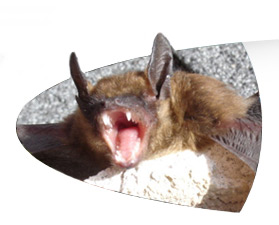Frequently asked questions about Bats and Bat Removal
How long does bat exclusion take?
Once the structure has been treated and the proper bat control devices have been installed, it usually takes two to four days for all the bats to leave. In the colder months it will take longer for bats to leave due to hibernation and low activity levels.
Is it safe? Will my family have to leave the home while it is performed?
Our bat exclusion services are very safe. There are no chemicals used whatsoever. There is no need for anyone living in the house to have to leave while the bat exclusion job is in process.
What types of health risks are associated with bats living in my house/building?
This is perhaps the most common question that we're asked, and there are some serious health risks associated with having bats in the house.
Rabies
Typically when a bat colony resides in a building, it is only a matter of time before one or many of the bats finds its way into the living space. This usually happens at night when everyone is asleep. It has been proven that a person can be bitten by a bat while sleeping, without ever knowing it. This poses a serious risk because bats are considered a high risk animal for carrying rabies in our area. In most cases when we take a bat out of a home it is recommended by the CDC (Centers for Disease Control) that the bat be sent for rabies testing. If the bat cannot be found, the CDC recommends that everyone that was in the home receive rabies vaccination shots. This entire process can be avoided by having the bats removed from your home. If you find a bat in your home see our page on what you can do yourself along with our main page on getting rid of bats for details on our services.
Bat Guano (Bat Droppings)
If there are bats in your attic or you had a bat in your building then there will also be bat droppings in the spaces the bats inhabit. Bat droppings are particularly hazardous due to Histoplasmosis — a disease that attacks the respiratory system.
When dried bat guano is disturbed (usually swept, vacuumed or walked on), there are small particles that become airborne (much like sweeping up dust or dirt). Histoplasmosis is contracted when these airborne particles are breathed into the lungs.
BatGuys strongly recommends that our customers do not attempt to clean up bat guano on their own. We provide complete bat guano removal services.
What do you do with the bats?
With the use of bat control devices in our bat exclusion services, the bats aren't actually caught. Bat control devices will allow the bats to exit the building but not re-enter. Once the bats realize that they cannot get back into the house they will go in search of a new dwelling. This process is approved by Bat Conservation International and is widely accepted as the most humane method of safely dealing with a bat infestation.
Is there any special training involved? Do you need a license to do bat exclusions?
Please see our credentials page.
The process seems so involved. Isn't there a simpler way?
No. The bat exclusion process is the only way to permanently remove a bat colony from a structure. Anything else is a waste of time and money. BatGuys does not offer any type of service for bat removal other than a complete bat exclusion.
It's also worth noting is that in order for a bat exclusion to be successful the entire building must be treated. If only one portion of the house is treated, bats will simply start using an untreated area and continue to inhabit the structure. This especially holds true for condominiums and duplexes. If one unit of a condominium has a bat colony in the attic the entire building needs to be treated — not just that unit.
If you have any questions regarding bats or the bat exclusion process that are not covered here, and would like to speak to a licensed bat specialist, or if you would like to set up an appointment for an inspection, please feel free to contact us using the information provided below.
